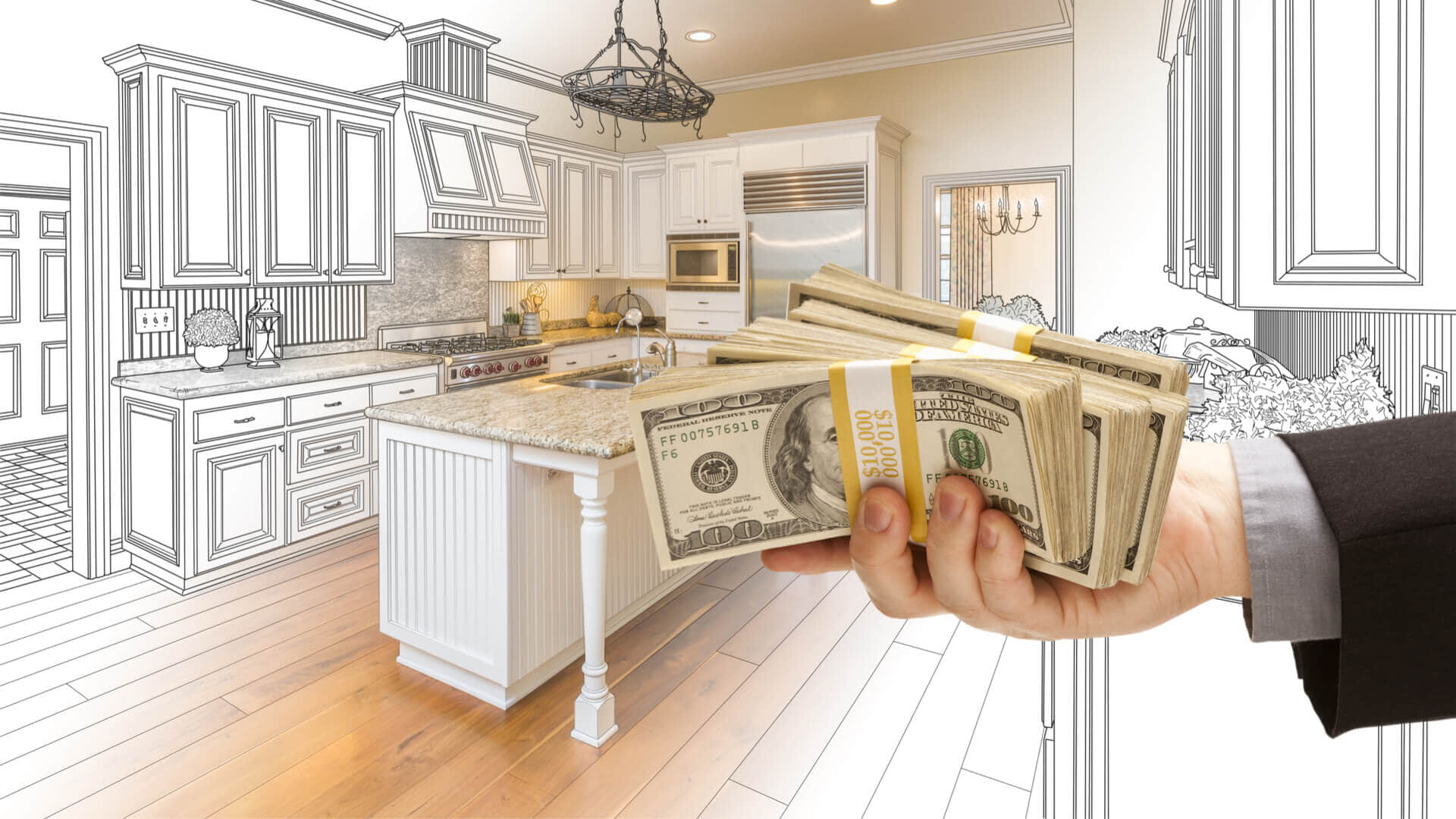The Pros and Cons of Financing Your Home Remodel
When the time comes to invest in your property, you want to make it count by creating the perfect space to fit your personality and needs. Whether it’s to update to older features of your home or to upgrade elements to maximize your return on investment (ROI), making major remodels to your home will likely mean that you will have to look at finance to fund carrying out these projects.
Financing your home remodel comes benefits and risks, and in this article we look at the pros and cons of the financing process.
The Pros of Financing Your Home Remodel

Increase the Value of Your Home
We all want to maximize the value of our properties; it’s one of the reasons that we purchased a home in the first place. Financing enables us to realize that dream of the perfect space and can be a way of keeping the costs to a minimum, while potentially maximizing your home’s value.
If the remodel is for resale, you will have to watch the markets to decide when the optimum time to sell might be. By using financing, you give yourself the chance of catching the market when prices are hot.
Tax-Deductible
As with your initial mortgage, any new financing that you take, excluding unsecured loans and credit cards, you can deduct the interest you pay at tax time. The IRS (Internal Revenue Service) provides tax deductions that are then used to reduce your tax burden. Interest on certain loans, such as secured and home equity loans, are classed as tax-deductible interest and can be claimed on your federal income tax return.
The amount you save depends on your marginal tax rate, but if you pay 25 percent, for example, and your tax deductible interest is $1,000, then you will save $250, reducing your loan burden by the same amount.
Affordable Rates
Many of the finance options are highly competitive, and in some cases offer better rates than you currently enjoy on your existing mortgage. That’s why it often makes sense to take advantage of better terms to reduce your overall financial burden.
The bonus is that you get all the improvement that your heart desires and a cheaper mortgage as well. It also pays to look at the size of the loan you need, because many credit unions and banks reserve their best interest rates to their customers who take out the most significant credit.

Get Those Small Projects Done
Not every home improvement is a significant overhaul project; maybe all you want is to redecorate or upgrade the furniture. If that’s the case, securing a personal loan may be the best option.
For less significant projects, an unsecured loan could be the route, especially as the decision by the lender is often quick, with the money readily available to use almost immediately. The repayment terms are also easier to manage as typically you will have a loan term of fewer years compared to credit secured against the property.
Instant Money
Many homeowners have grand ideas about what they can do to improve their homes, and that’s fine if you have the cash available. If, though, like the majority of homeowners, you need finance to get things done, taking a loan is the quickest way to achieving your goals. It means that you get the house improvements you want without the hassle of saving up and delaying the build for months or even years.
Get all the Jobs Done in One Hit
Home improvements aren’t always about major remodels, because over time you start to build up a list of jobs that eventually leave you feeling dissatisfied with your home.
Kitchens often start to look tired or dated, bathrooms age, and families grow. By using finance, you have the opportunity to tie up all these loose ends, improving your quality of life and the enjoyment of your home. The other advantage is that instead of trying to pin a contractor down several times to keep returning to do the jobs bit by bit, you can schedule them to be on site until the works are complete.
Book a Contractor When it Suits You
Contractors are busy people, especially if their work is of a high standard and they have a large clientele, so having the finance in place gives you the means to pique a contractor’s interest and thus prioritize your remodel in their queue of projects.
Contractors are continually juggling skilled tradespeople and materials from job to job, so getting priority means that the work progresses at a faster pace, and there aren’t any delays while you wait for another project to complete to free up the trades that you need.

Add More Luxury
When considering a remodel, you may be constrained by the budget or the costs, but with finance, primarily home equity loans that spread the cost over 15 or 30 years, you can splash out on those extras you always wanted but were afraid you couldn’t afford. Suddenly, your remodel has transformed from a basic upgrade to a showstopper overhaul that will wow friends and neighbors and leaves you feeling like you live in a movie-star mansion.
Enjoy Your Home Now
Time ticks by as you try to save for the improvements that will enhance your living space, but often once you’d saved enough to do what you originally wanted your priorities have changed. Often, we wish we had the money right now because what we want reflects that particular moment in our lives.
Finance offers you that opportunity instantly. Get the work done, and get down to enjoying it until you change your mind and want the whole thing done again.
The Cons of Financing Your Home Remodel

The Cycle of Debt
Financing is a tool that puts you in control. It gives you the means to do what you want and enjoy the fruits of your hard work. Keep in mind, though, that you don’t want to end up in the dreaded “cycle of debt.”
Banks and credit unions need you to be in debt because it keeps them in business. This means that, when it comes to financing, you stay in control as long as you repay your loans; if your loans start to stack up, though, the banks become in control of you. Getting trapped in the cycle of debt is easy to do, borrowing to pay other loans, and yet never freeing yourself and always chasing your tail. Always try and pay down one debt before embarking on another.
Interest Rates
Interest rates change. That’s a fact of life. You may have refinanced your home to pay for your luxury remodel, but as the economy changes and the federal bank sets new interest rates, those once-favorably rates might disappear. This changes can increases your monthly burden and can make your home remodel seem like a bad decision.
Watch the Housing Market
We feel good when we know there is equity in our homes. Refinancing on a home equity scheme allows us to take the difference of what the property is worth and the outstanding mortgage so we can use it as cash to fund whatever improvements we want.
When markets crash, though, just like they did in 2007/2008, many homeowners saw their equity wiped away. In an area where there were high numbers of foreclosures, some home dropped in value by 10 to 20 percent. In March 2007, for example, the National Association of Realtors said that the median house price fell by 6 percent compared to the same month the previous year. By taking money out of your equity, you risk closing the gap on what you owe and what you own.

The financial stress
By overstretching your finances, you could be exposing yourself to a higher level of stress. Struggling to make ends meet is not the best position to be in, especially if you did it by racking up too much finance trying to realize a dream. At some point, the monthly interest costs are going to exceed the amount you can comfortably pay, and that will lead to missed or late payments. The inevitability of all this mismanagement is foreclosure.
The other danger with accepting high levels of debt is adopting the mindset that once you are in this cycle you become numb to the misery it causes. Using your credit cards become habit-forming, and suddenly you discover that the debt has increased beyond your control.
Going for that entire remodel
A excellent way to minimize the level of finance you need to take is to manage one remodel job at a time. Trying to slot everything in one go sounds like a great idea, but the costs may be too difficult to bear, and you may struggle with the repayments. By dividing the tasks in order of importance, you prioritize the essential works first, leaving the luxuries until you have paid down the existing remodel debt sufficiently to enable you to look at more finance.
Increased monthly payments
By taking on more finance, you are inevitably going to increase your monthly financial burden, so you should give some serious thought to the implications of raising the level of credit you have. Only take out credit if you are in a stable position at work, and there aren’t any other factors that might scupper your plans.
Remember that your reason for the remodel in the first place was to transform your home into a space you always wanted, so by taking on an unsustainable amount of finance, you are going to take the shine off your home improvement. In time you might come to regret it, or even worse, hate it.
Debt to Income Ratio (DTI)
DTI is the measure of the level of debt you have compared to your gross annual salary. Most lenders like to see this level no greater than 38 percent; however, the absolute maximum not to be exceeded is around 43 percent.
A better way to look at it is to remember that if you have a DTI of 43 percent, for every gross dollar you earn, $0.43 is going toward managing a debt payment, effectively almost halving your income.

Extending the mortgage
When we start on the housing ladder, we dream of owning a property, and as we progress through the years, that dream becomes one of being mortgage free. Extending the term of your mortgage by refinancing for an expensive remodel means you are prolonging the amount of time you remain indebted to the bank or credit union. Choosing the right time to do this is crucial as you wouldn’t want to be paying down an expensive debt well into your seventies.
Some Options are Cheaper Than Others
The type of finance you choose has a significant impact on your repayment costs. Cash-out loans are more expensive to take than home equity plans, and credit cards are the most costly method of them all. Some finance options are designed to be short term fixes, like unsecured loans, while others are intended to cover the major things that usually take years to pay off.
Whichever finance route you choose, decide on how much you need to complete the remodel and how long you are going to take to pay it back. If the prospects of a swift repayment are slim, then think long term and spread the costs.
Final Thoughts
There are no right and wrong answers when it comes to deciding which financing option suits your needs; only you know what you want to spend and how much you can afford to pay back.
Ask yourself:
- Payments – Can you afford them comfortably?
- Prudence – Do you need that swimming pool or gold-plated faucets?
- Patience – Can you wait a little longer if it means you’ll save in the long run?




